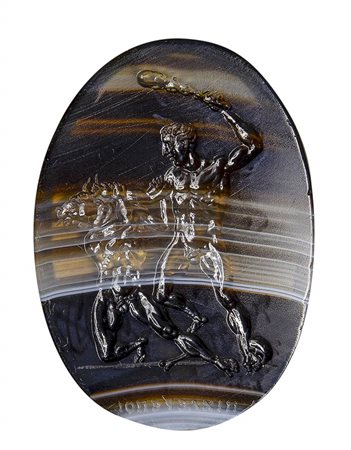 Bertolami Fine Art - Riversdell Close 27, KT16 9JW Chertsey
Bertolami Fine Art - Riversdell Close 27, KT16 9JW Chertsey
WEB AUCTION 106: Glittica WEB AUCTION 106: Glittica
Friday 12 November 2021 hours 15:00 (UTC +00:00)
A large neoclassical banded agate intaglio by Pichler. Theseus and the Minotaur.
A large neoclassical banded agate intaglio by Pichler. Theseus and the Minotaur.
19th century.
24x34x4 mm
The famous mythical episode in which Theseus killed the Minotaur is represented here in a powerful scene engraved on a large banded agate. The hero is giving with a club the fatal strike that will kill the beast, represented with one knee on the ground, in agony, blocked by the arm and by the right leg of Theseus. The postures of both characters are elegant, typically neoclassical after an original roman marble group found in 1740 in Genzano, near Rome, than into the Albani collection ("217. Group of Theseus killing the Minotaur, in the same way that this fact is represented in Athens medal at the Caylus tom. 3 p. 131. Ant. Gr. Plate 34 n.4 .... It was found in the year 1740 in Genzano ... "). This scene is present in a very similar way, with some variations, on some Roman coins (Attica, Athens, 145/55-175 AD, on the reverse The Minotaur holding a club in his right hand, left hand holding an horn of the Minotaur kneeling, who is preparing to slay, SNG Copenhagen 341 var.; Bithynia, Nicomedia, Severis Alexander SNG von Aulock 784). This model was also followed in the neoclassical glyptic production, as evidenced by a rare glass impression from the Paoletti collection (yellow glass, inv. MR 28112, The Minotaur killed by Theseus, from an unsigned intaglio in sardonic, London, British Museum coll. Blacas 1866, erroneously attributed at the time to Marchant). In the Pichler gem, the anatomic rendering and all the details are engraved with great artistic and technical mastery. The musculature is marked and well proportioned with elegance, the poses are never rigid. Great skill also revealed by the feet in perspective, and by the features of the faces. In particular, the physiognomic rendering of the face of Theseus is interesting, very similar to some Antonio Canova portraits. It was the sculptor himself, in 1781-83 (London, V&A) who sculpted a statuary group with Theseus and the Minotaur, portrayed after the violent fight. In this Pichler's intaglio, the presence of human bones of the Minotaur's victims is also interesting, in the same style as some Poniatowski gems. This banded agate carving has the "PICHLER EPOI (EI)" signature in greek letters, with abbreviation; the signature is well centered in the clear band of the stone. This signature is attributable with good certainty to Antonio Pichler. (1697-1779), father and progenitor of the famous dynasty of engravers (see Index of Greek signatures in Coll. Paoletti II p. 491). This attribution is also supported by the more severe engraving style, in line with several currently known works made by Antonio. Beautiful variety of banded agate. Wear marks.
L.Pirzio Biroli Stefanelli, La collezione Paoletti. Stampi in vetro per impronte di intagli e cammei, vol. II, p. 305 n. 295; C. Fea, Indicazione antiquaria per la villa suburbana dell'eccellentissima casa Albani, sec. Ed. Roma 1803, p. 24.
"
U.K. private collection







